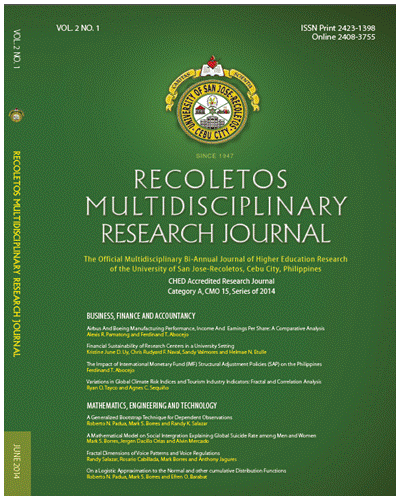The Satisfaction Congruency Theory: The Case of Sexual Satisfaction
DOI:
https://doi.org/10.32871/rmrj1402.01.18Keywords:
congruent satisfaction, sexual satisfaction, satisfactionAbstract
The culture of putting primacy to pleasure and satisfaction is gaining headway not only in the Philippines but in the world as well. It is slowly building a counter culture to the Catholic beliefs that the missionary friars propagated. Religion taught the people that sex is sacred, and rendered it as taboo in this culture. In this paper, the dynamics of satisfaction congruency in human behavior is delved into using the axiomatic approach to theory development. Self evident truths are explored to form the base of the theory building process. The developed theory states that congruent satisfaction is dependent on whether or not there is satisfaction in each of the three phases of an act. Congruent satisfaction occurs when the individual is satisfied in all these three phases: antecedent/planning phase, concurrent/execution phase, and the consequent/evaluation phase. Dissatisfaction in any of the phases results in incongruency. This, in turn, will influence the quality of life of the individual.
References
Bandura, A. (1997). Self-efficacy: The exercise of control. New York: Freeman.
Byers, E. S. (2004). Relationship satisfaction and sexual satisfaction: A longitudinal study of individuals in longâ€term relationships. Journal of Sex Research. Canada: Routledge Taylor & Francis Group. Doi:10.1080/00224490509552264
Chao, J. K., Lin, Y. C., Ma, M. C., Lai, C. J., Ku, Y. C., et. al. (2011). Relationship among sexual desire, sexual satisfaction, and quality of
life in middle-aged and older adults. Doi:10.1080/0092623X.2011.607051
Cyranowski, J. M. (1998). Schemas, Sexuality and Romantic Attachment. Journal of Personality and Social Psychology, 74 (5), 1364-1379
DeLamater, J., Hyde, J. S. & Fong, M. C. (2008). Sexual Satisfaction in the Seventh Decade of Life. Journal of Sex & Marital Therapy; 34 (5), 439-454.
Durkheim, E. (2002). Moral Education: A study in the Theory and Application of the Sociology of Education. The Free Press. Retrieved on May 10.
Fullbright, Y. K. (2008). Pleasuring the Secrets of Sexual Satisfaction.Retrieved June 7, 2013.
Glanz, K., Rimer, B.K. & Lewis, F.M. (2002). Health Behavior and Health Education. Theory, Research and Practice. San Fransisco: Wiley & Sons.
Harvey, J.H., Wenzel, A. & Sprecher, S. (2004). The Handbook of Sexuality in Close Relationships. Retrieved May 10, 2013.
Hodgson, D. (2012). Rationality + Consciousness = Free Will. Retrieved on May 10, 2013.
Hull, T. H. (2008). Sexual Pleasure and Wellbeing. International Journal of Sexual Health . Oxfordshire, England: Routledge Journals. Retrieved on May 10, 2013.
Kohlberg, L. (1973). The Claim to Moral Adequacy of a Highest Stage of Moral Judgment. Journal of Philosophy, 70 (18), 630-646
Koneke, V. (2009). Psychology of Self-Insight-Motivated Reasoning and Self-Deception. Retrieved May 10, 2013.
Lawrance, K. and Byers, E. S. (1995). Sexual satisfaction in long-term heterosexual relationships: The Interpersonal Exchange Model of Sexual
Satisfaction. Personal Relationships., 2: 267–285
Litzinger, S. & Gordon, K. C. (2007). Exploring relationships among communication, sexual satisfaction, and marital satisfaction. Journal of Sex & Marital Therapy. Doi:10.1080/00926230591006719
Nauert, R. ( 2010). Updated Maslow’s Pyramid of Needs. Perspectives on Psychological Sciences.
Seward, J. (1956). drive, incentive, and reinforcement. Psychological Review, 63, 19-203.
Sprecher, S. (2010). Sexual satisfaction in premarital relationships: Associations with satisfaction, love, commitment, and stability. Journal of Sex Research. Retrieved on May 10, 2013.
Wong, A (2000). Kohlberg’s Stages - Explained & Illustrated
Wike, E., & Barrientos, G. (1958). secondary reinforcement and multiple drive reduction. Journal of Comparative and Physiological Psychology, 51, 640-643.
Yates, D. (2011). Needs and Subjective Well-Being Around the World. Journal of Personality and Social Psychology.
Downloads
Published
How to Cite
Issue
Section
License
Copyright of the Journal belongs to the University of San Jose-Recoletos


